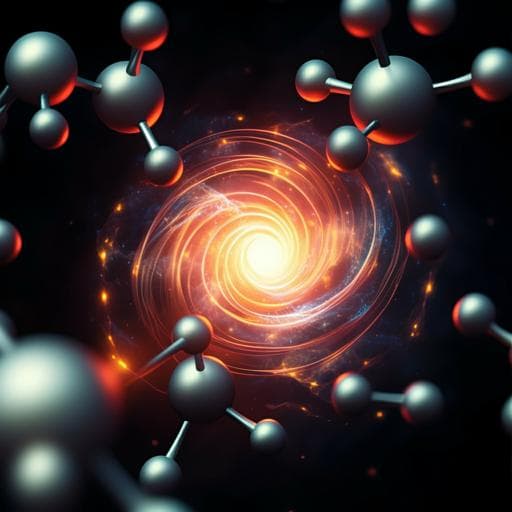
Chemistry
Photocatalytic CO₂ reduction using La-Ni bimetallic sites within a covalent organic framework
M. Zhou, Z. Wang, et al.
This innovative research reveals an electrostatically driven self-assembly method for synthesizing an advanced photocatalyst with bifunctional LaNi sites. Achieving a remarkable 15.2-fold enhancement in CO₂ reduction rates, this work, conducted by Min Zhou, Zhiqing Wang, Aohan Mei, Zifan Yang, Wen Chen, Siyong Ou, Shengyao Wang, Keqiang Chen, Peter Reiss, Kun Qi, Jingyuan Ma, and Yueli Liu, offers a groundbreaking strategy in the quest for efficient CO₂ reduction.
~3 min • Beginner • English
Introduction
Artificial solar-driven CO₂ reduction using semiconductor photocatalysts is a promising route to carbon-neutral fuels, but achieving high activity and selectivity remains challenging. Single-atom catalysts (SACs) offer high atom utilization and selectivity for CO₂ reduction reactions (CO₂RR), yet often suffer from limited light absorption, competing hydrogen evolution reaction (HER), and ill-defined active sites. Ideal photocatalysts should combine efficient photo-absorption and robust carrier separation with highly selective catalytic centers. Dual-atom catalysts (DACs) can synergistically integrate adjacent metal sites to optimize charge transfer and tune catalytic pathways, potentially overcoming SAC limitations. Crystalline porous scaffolds such as covalent organic frameworks (COFs) provide ordered pores, high surface areas, and abundant binding sites to stabilize atomically dispersed metals and modulate charge separation through strong catalyst–substrate interactions. This study proposes an electrostatically driven, phenanthroline-assisted self-assembly of La-Ni diatomic sites (LaNi-Phen) within COF-5 colloids to couple an optically active La site with a catalytically active Ni site for selective CO₂-to-CO photoreduction. The central hypothesis is that directional charge transfer between La and Ni, mediated by COF-5, will enhance carrier generation, lower the barrier for *COOH formation, and yield higher CO rates and selectivity without external photosensitizers.
Literature Review
Prior studies have demonstrated SACs can selectively drive CO₂RR but face constraints in light harvesting, suppression of HER, and interaction with substrates. DACs have emerged to leverage synergistic interactions between neighboring metal centers, improving charge transfer and enabling cooperative catalysis; for example, Ni–Fe diatomic sites on N-doped carbon reduced barriers for COOH* formation and CO desorption in electrocatalysis. Porous frameworks (MOFs and COFs) provide well-defined porosity, high surface area, and tunable binding sites to anchor isolated metal atoms, with confinement effects that stabilize active sites and influence carrier dynamics. Despite progress, detailed insights into the roles of specific single-atom sites within DACs and their substrate interactions during dynamic photocatalysis remain scarce. This work builds on these advances by installing rare-earth/transition-metal La–Ni diatomic sites into COF-5 to couple light absorption and catalytic activity and to elucidate the charge transfer pathway and reaction intermediates via in situ spectroscopy and DFT.
Methodology
Synthesis: COF-5 colloids were prepared from HHTP (5 mM) and PBBA (7.5 mM) in acetonitrile:1,4-dioxane:mesitylene (80:16:4 v/v/v; 20 mL), sonicated 3 min, filtered (0.45 µm PTFE), and heated at 90 °C for 24 h. Colloids were washed with acetone and re-dispersed in the solvent mixture. LaNi-Phen/COF-5 was synthesized by dispersing COF-5 colloid (3.3 mL, 10 mg) in acetonitrile (5 mL), then sequentially adding NiCl₂·6H₂O (0.52 mg, 2.2 µmol), stirring 30 min under N₂; Phen (18 mg, 0.1 mmol), stirring 1 h; LaCl₃·6H₂O (1.2 mg, 3.3 µmol), stirring 12 h at 25 °C under N₂. The product was isolated by centrifugation and vacuum-dried at 60 °C for 24 h. Control materials (Ni-Phen/COF-5 and La-Phen/COF-5) were synthesized analogously using single salts; a physical mixture (Mix-LaNi-Phen/COF-5) was prepared by mixing 10 mg each of La-Phen/COF-5 and Ni-Phen/COF-5.
Characterization: PXRD verified COF crystallinity. Morphology and atomic dispersion were examined by HRTEM and AC-HAADF-STEM. XPS determined oxidation states and N coordination shifts. FTIR confirmed Phen retention. UV–vis DRS and Tauc plots provided bandgaps; UPS measured Fermi level and VBM to derive CBM vs NHE. BET and CO₂ adsorption assessed porosity and uptake. XAFS (Ni K-edge, La L₃-edge) and EXAFS fitting probed local coordination and La–Ni bonding; CO-DRIFTS distinguished ionic La–Ni from metallic nanoparticles. In situ XAFS monitored oxidation state changes under Ar/CO₂ and light. In situ DRIFTS tracked CO adsorption (bridging CO) and CO₂-derived intermediates under humid CO₂ with and without illumination. Photophysical/electrochemical studies included steady-state PL, TRPL, photocurrent I–t, and EIS.
Photocatalytic testing: 10 mg catalyst and 10 mM BIH in 50 mL solution (48 mL acetonitrile, 2 mL H₂O) in a sealed Pyrex reactor. After evacuation, CO₂ (−80 kPa, 99.999%) was introduced, equilibrated, and irradiated with a 300 W Xe lamp (~100 mW cm⁻²) at 10 °C. Products (CO, H₂) were quantified by GC; isotope tracing used ¹³CO₂ with GC–MS. Cycling, heterogeneity, and stability were assessed over multiple runs with post-reaction XRD/FTIR/XPS/TEM.
Computations: DFT (Materials Studio) with GGA-PBE, 700 eV cutoff, 2×2×2 k-point sampling. Convergence thresholds: max force 0.002 Hartree/Å, max displacement 0.005 Å, energy change 1.0×10⁻⁵ Hartree. Formation energies, reaction barriers for intermediates (*COOH, CO*), and HOMO–LUMO distributions for LaNi-Phen were calculated.
Key Findings
- Structure and dispersion: AC-HAADF-STEM visualized atomically dispersed La and Ni within COF-5 with a La–Ni distance ~2.8 Å. No nanoparticles observed. XPS indicated Ni²⁺ and La³⁺, with N 1s upshift confirming strong Phen–metal coordination. CO-DRIFTS showed a 2117 cm⁻¹ band consistent with linearly adsorbed CO on ionic La–Ni species; absence of the 2092 cm⁻¹ band excluded metallic La–Ni nanoparticles.
- Coordination environment: EXAFS R-space showed dominant Ni–N (~1.57 Å) and La–N (~1.72 Å) peaks and small peaks at ~2.90 Å (Ni K-edge) and ~2.88 Å (La L₃-edge) evidencing La–Ni coordination. Fitting favored La–N₃/Ni–N₃ over La–N₄/Ni–N₂; DFT formation energy lower for La–N₃/Ni–N₃ (−51.760 keV vs −51.747 keV). Pore confinement in COF-5 promoted the preferred six-coordinate diatomic structure; free LaNi-Phen formed fully coordinated La–N/Ni–N₆.
- Optical/electronic properties: La incorporation induced a red shift in UV–vis absorption and reduced bandgap from 3.12 eV (COF-5) to 2.86 eV (LaNi-Phen/COF-5), enhancing light harvesting. UPS gave cut-off and Fermi edges of 15.93 eV and 0.76 eV; E_Fermi = 5.27 eV. VBM at −6.03 eV vs vacuum translates to +1.53 V vs NHE; with Eg = 2.86 eV, CBM = −1.33 V vs NHE, suitable for CO₂/CO reduction (E° −0.53 V).
- Photocatalytic performance: Optimized LaNi-Phen/COF-5 achieved CO evolution of 605.8–608 µmol g⁻¹ h⁻¹ with 98.2% CO selectivity, outperforming COF-5 (39.9 µmol g⁻¹ h⁻¹; 70.7% selectivity), La-Phen/COF-5 (195.4 µmol g⁻¹ h⁻¹; 95.9%), Ni-Phen/COF-5 (224.4 µmol g⁻¹ h⁻¹; 91.2%), and the physical mixture (115.9 µmol g⁻¹ h⁻¹). Total electron transfer reached 1,235.0 µmol g⁻¹ h⁻¹. Stable over at least 5 cycles with negligible loss; structure retained (XRD/FTIR/XPS/TEM).
- Charge separation/transport: PL quenched relative to COF-5; TRPL lifetime reduced from 4.75 ns (COF-5) to 0.53 ns (LaNi-Phen/COF-5). EIS Nyquist radius minimized for LaNi-Phen/COF-5, indicating lowest charge-transfer resistance, with enhanced photocurrent.
- In situ spectroscopies: DRIFTS detected bridging CO (1800–1900 cm⁻¹) only for LaNi-Phen/COF-5, indicating effective CO adsorption on dual sites. In situ Ni K-edge XANES showed increased white-line intensity in CO₂-saturated solution versus Ar (Ni oxidation state increase due to electron transfer to CO₂), partially recovering under illumination, consistent with catalytic cycling. La L₃-edge also showed oxidation state variations. CO₂ adsorption intermediates observed in dark: v₃(O–C–O) 1634 cm⁻¹, bidentate carbonate (1537–1562 cm⁻¹), monodentate carbonate (1494–1508 cm⁻¹), bicarbonate (1439–1462 cm⁻¹), and v₃(CO₂) ~3595–3727 cm⁻¹. Under illumination, bands at 1691 cm⁻¹ (CO₂*), 1540/1511 cm⁻¹ (*COOH), and 2036 cm⁻¹ (CO*) increased with time, evidencing the reaction pathway.
- Isotope labeling: ¹³CO₂ produced ¹³CO with dominant m/z = 29, confirming CO originated from CO₂.
- DFT mechanism: CO₂ binds with bending, interacting with Ni. Calculated barriers: formation of *COOH 0.65 eV (rate-limiting), CO* formation 0.04 eV, CO desorption 0.72 eV versus CHO* formation 1.02 eV, explaining high CO selectivity. HOMO localized on Ni-Phen and LUMO on La-Phen, supporting La as electron donor/optical center and Ni as catalytic center, with COF-5 acting as an electron bridge for directional transfer.
Discussion
The integration of La–Ni diatomic sites within COF-5 effectively couples light absorption and catalytic activity at spatially proximate centers. La acts as an optically active electron donor that enhances light harvesting and drives carrier generation, while Ni serves as the catalytic center binding and activating CO₂. The COF-5 scaffold facilitates directional charge transfer: photoexcited electrons migrate from La-Phen through the COF-5 framework to Ni-Phen, where CO₂ is reduced via a *COOH intermediate. In situ XANES/DRIFTS and DFT corroborate this mechanism, showing Ni oxidation state modulation during CO₂ activation, accumulation of *COOH and CO* intermediates, and low barriers for CO* formation and CO desorption relative to competing pathways (e.g., CHO*), which explains the high CO selectivity and suppressed HER. The reduced bandgap and favorable band alignment (CBM −1.33 V vs NHE) enable efficient CO₂-to-CO conversion without external photosensitizers. Synergy between the bimetal centers and COF confinement yields accelerated charge separation (shorter lifetimes, higher photocurrent, lower impedance), translating into a 15.2-fold activity increase over pristine COF-5 and near-quantitative CO selectivity.
Conclusion
A phenanthroline-assisted, electrostatically driven self-assembly strategy was developed to incorporate atomically dispersed La–Ni diatomic sites into COF-5, producing a bifunctional photocatalyst that unites light-harvesting (La) and catalytic (Ni) functions. Comprehensive structural characterization confirmed atomically dispersed La–Ni with direct coordination inside COF-5. Optical/electronic measurements and in situ spectroscopies, together with DFT, revealed directional charge transfer from La through COF-5 to Ni and a CO₂ reduction mechanism proceeding via *COOH and CO* intermediates with favorable energetics for CO formation. The catalyst achieves 605.8 µmol g⁻¹ h⁻¹ CO production with 98.2% selectivity and excellent stability without added photosensitizers. This scalable approach provides a design blueprint for dual-atom sites in porous COFs to synergistically integrate light absorption and catalysis; future work can extend the concept to other rare-earth/transition-metal pairs, tailor coordination environments, and optimize framework–metal interactions for broader product scopes and operating conditions.
Limitations
Related Publications
Explore these studies to deepen your understanding of the subject.







